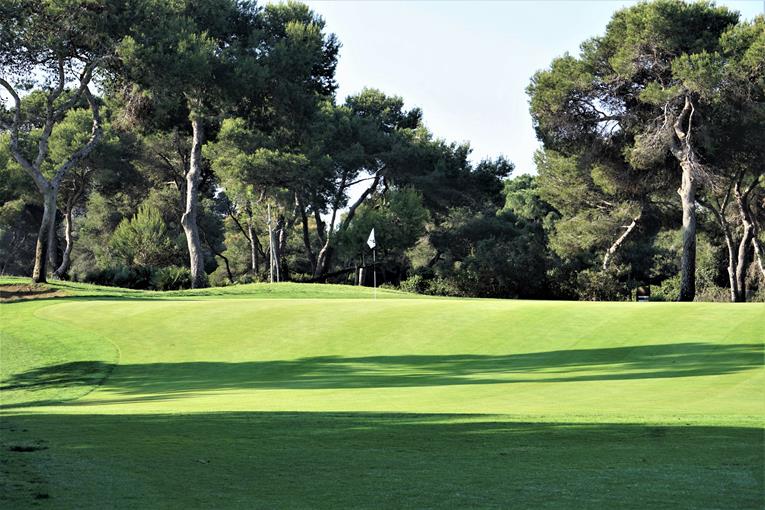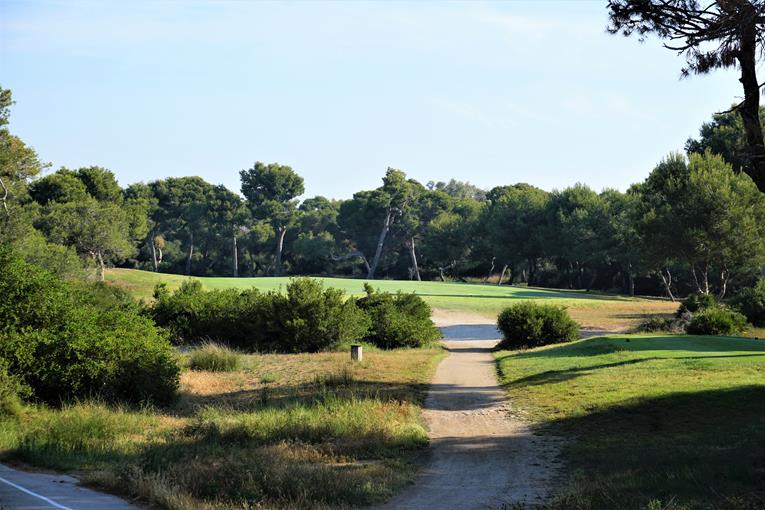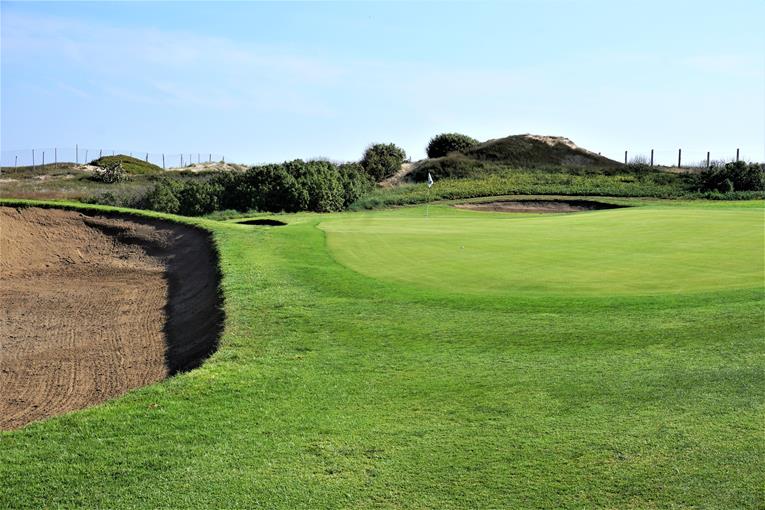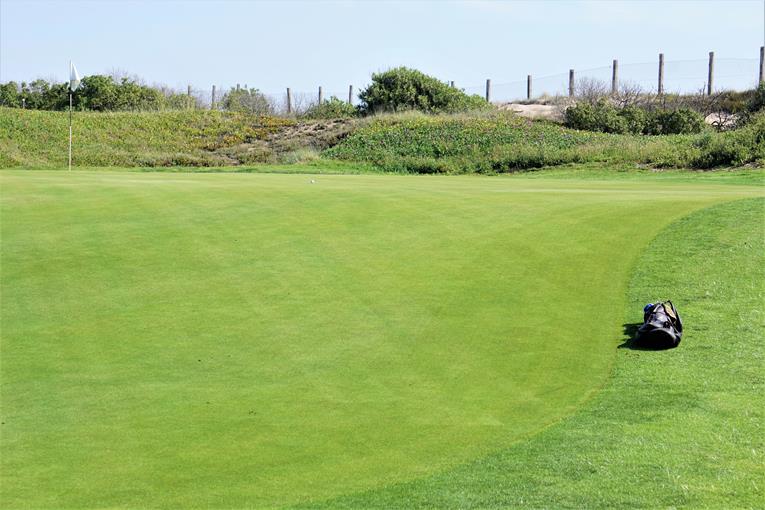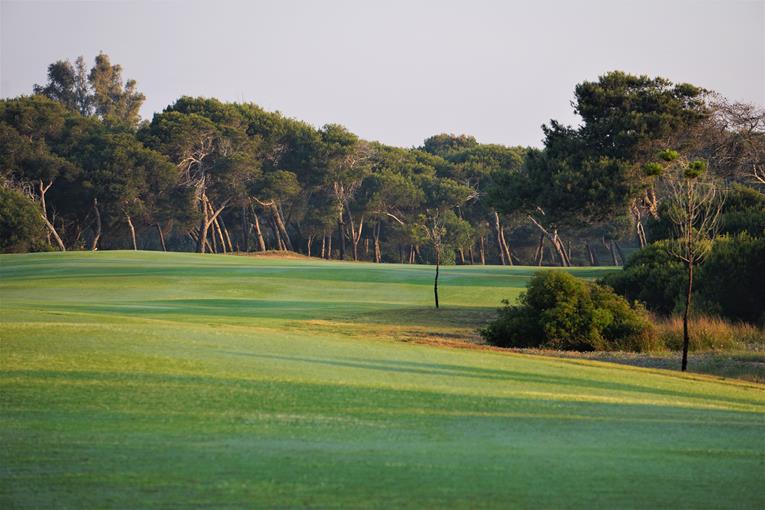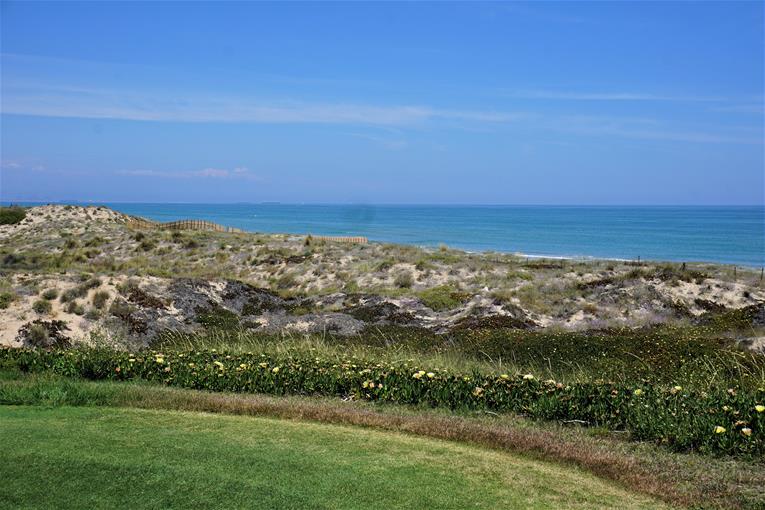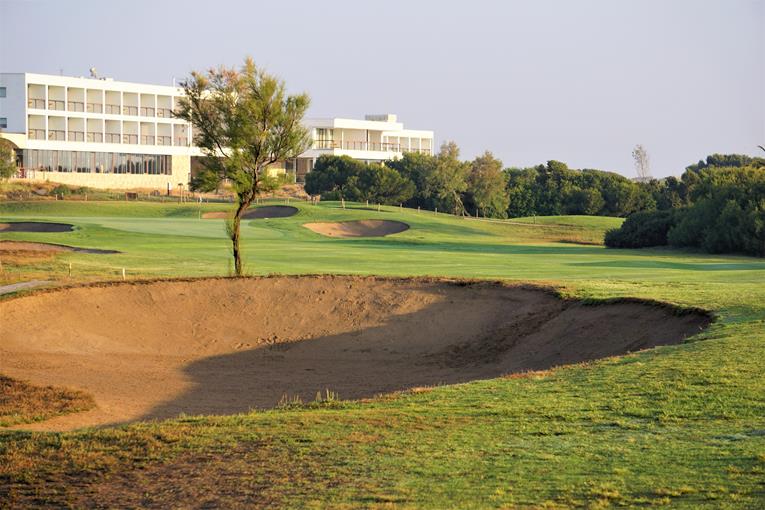Campo de Golf del Parador de El Saler
Spain

Javier Arana, one of golf’s gentlemen, was given his best property late in his career and knew just what to do. Golf course architecture was no longer only the preserve of English speaking men.
Golf evolved differently around the world and each nation featured its own set of protagonists as well as land and soil unique to that region. In Spain, the man who did the most to shape the game was Javier Arana. His early interactions with Harry Colt and later Tom Simpson (with whom he would partner after World War II) established a Golden Age design ethos that Arana brought into the modern era. Spain was fortunate to have a man of that substance and quality when it needed one.
Like most countries where the game has been played for over a century, rudimentary courses in Spain were the result of people laying out nine holes without prior experience in doing so. Green keeping practices were basic and sand greens were the norm. Chasing a little white ball in the great outdoors provided enough simple pleasure, at least in the early stages. Spain’s expansive coastline and rolling topography in population centers like Madrid created grand opportunities and not surprisingly, the game gained a foothold.
Soon, the founders of clubs pursued experienced golf architects. A group of influential businessmen in Madrid hired Harry Colt to build Puerta de Hierro in 1912. The quality of his holes was high, thanks to a routing that took advantage of the property’s valleys and ridges, even though the course initially measured well under 6,000 yards. Alfonso Erhardt, who penned the marvelous book entitled The Golf Courses of Javier Arana (published in 2013 and available in English here www.javierarana.com/english), nominates 1928 as a key moment in the game’s development in Spain. That’s when Colt returned to build Pedreña on the outskirts of Santander on Spain’s north coast. Nine holes opened in 1928 and the other nine the following year with the course being such a joy to play, far superior to anything else in Spain at the time that every club took notice.
Erhardt described the seminal event:
Colt’s design for Pedreña constituted an immense qualitative leap forward from his previous work in Spain: he took a sharply modern approach to the exposed cliffs of the Bay of Santander and extended his design over 5,400m – this was stunningly ambiguous for Spain at the time, given that Puerta de Hierro and Sant Cugat were both less than 5,000m. … It may seem a naive overstatement to claim that Pedreña reinvigorated the Spanish golf world of that time – but the opening of the new club ushered in an era of rapid development that was to last until the Civil War.
Where was Javier Arana? At the time he was a 24 year old accomplished golfer who had been elected as green chairman at Real Sociedad de Golf de Neguri, which at the time was an eleven hole course along a beach about an hour’s drive from Pedreña. Guess who called on Neguri? None other than Harry Colt, who was invited to make improvements to the course as well as to approve a potential new clifftop site (Arana ultimately built Neguri’s present day course in 1961 on the Colt approved site). As Erhardt notes, Arana’s ‘…meeting Colt, the new courses in Madrid and Santander, and the renovation work at Puerta de Hierro gave Arana a first glimpse of the subtleties of design theory. This learning process inspired him to oversee changes to Neguri so that it could keep abreast of the gradual rise in standards in Spanish golf and bring it into alignment with the new design currents.’
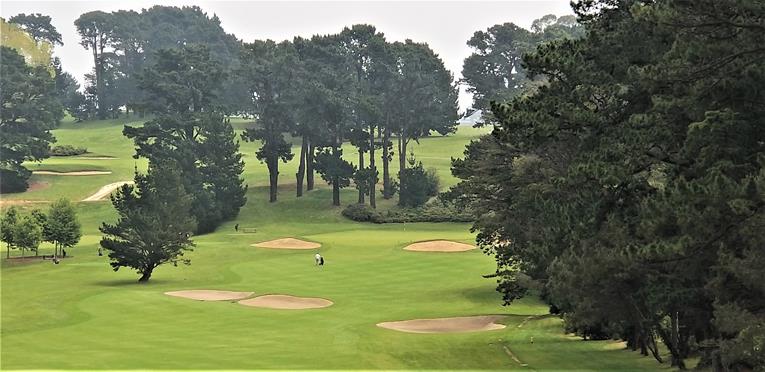
Pedreña elevated golf course architecture in Spain to unseen levels. In particular, the downhill 6th featured cross bunkers and a steeply pitched green. That hole left Colt in a tough situation at the bottom of the hill but …
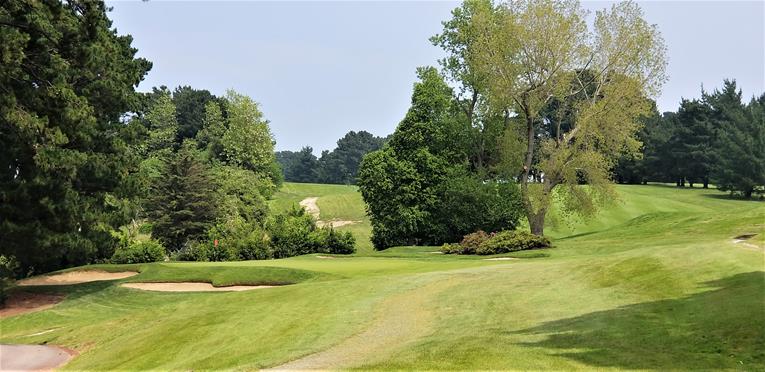
…he expertly routed the one shot 7th along the side of the hill, perhaps, emulating the 8th hole at Sunningdale Old.

After the 7th seamlessly stair-steps the golfer up the hill, Colt draped the 8th over the far side and exposed the golfer to this wondrous view of the river estuary below.

Once on top, Colt laid out a series of fine holes. The Bay of Biscay acts as the backdrop to the short iron approach to the 14th, above. Colt’s four hole finish is stirring and remains the equal of any in Spain.
To be sure, the property at Pedreña was neither too large nor ideally suited for golf given a hill occupied much of the land. Nonetheless, in the hands of a supreme tactician, the routing turned into something that was exhilarating and the golf matched the glorious scenery. A novice could not have produced what Colt adroitly did at Pedreña.
Arana took notice and his architectural awareness deepened when he competed at some of Europe’s finest courses. One event occurred in 1932 at Chiberta in France. Erhardt writes, ‘Chiberta, a course designed by Tom Simpson, was always Javier’s favourite. Spread out across sand dunes and pine forest near Biarritz, Chiberta was distinctive for its variety and the creative use of the natural unevenness of the ground. … The rich variety of the hole styles, and the way in which each hole cleaved to the features of the terrain, so forcing the player to think before executing each shot, left a deep imprint on Arana’s vision: Chiberta was a radical break from most of the venues he had been acquainted with so far.’
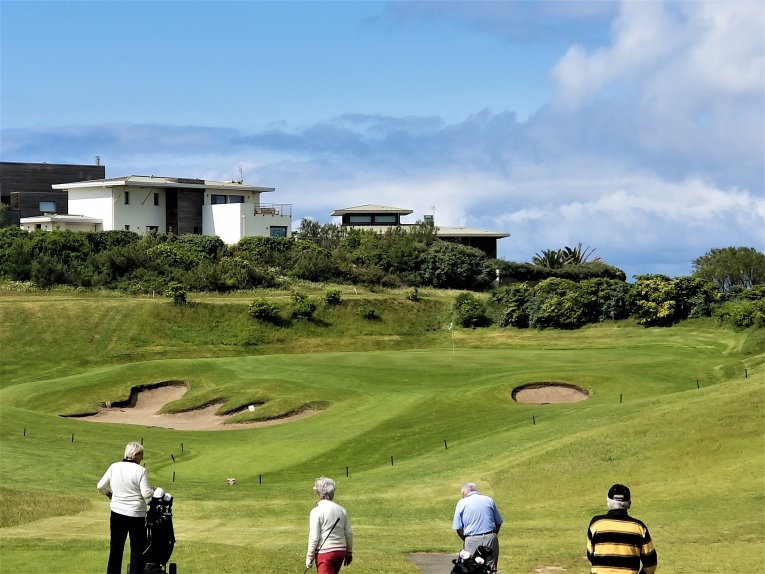
Chiberta’s mix of coastal and inland holes made it a special course in Simpson’s day. Today, houses impose on the playing experience.
Arana’s playing career and participation in international matches was in full flight in the mid 1930s. He was a regular at the French Open and also played in the British Amateur and the Open. He and his brother were arguably the two best golfers on the continent in the 1930s. According to Erhardt, Javier Arana’s ability to drive the ball coupled with a deft putting stroke separated him from the rest but his skills meant nothing when the Spanish Civil War broke out in 1936. After three bloody years the country was in tatters and compounding the turmoil was the German invasion of Poland. Arana was 40 years old when World War II ended and his competitive golf career was effectively over. Nonetheless, his appreciation for architecture and keen interest in agronomy meant that he was the ideal person to help his country restore and reinvigorate its golf scene. His first commission was to rebuild Club de Campo in Madrid and he would go on to build nine more courses, partnering in 1945 for three years with Simpson himself.
As detailed in The Golf Courses of Javier Arana, Arana’s two primary influences were Colt and Simpson. That is a pretty spectacular one-two punch! From these two giants Arana acquired the ability to build great holes and just as importantly, the ability to avoid building weak ones. The end result is the kind of courses that golfers delight in playing where the balance between fun and difficulty is expertly achieved. All three men were from the ‘less is more’ school and worked hard to find the best green sites and then work backwards. None were prone to the heavy-handed use of artificial hazards (a.k.a. bunkers) and keeping the vast majority of greens open in front is their hallmark. Be it Colt’s Royal Portrush or Simpson’s Ballybunion or Arana’s El Saler, the wind comes from several directions. The architecture at all three locations needed flexibility to accommodate the shifting winds. Indeed, at El Saler there is often a calm morning but the wind strengthens, blowing off shore by late morning. In the afternoon, it can be two clubs in your face off the sea, having turned 180 degrees in a scant four hours!
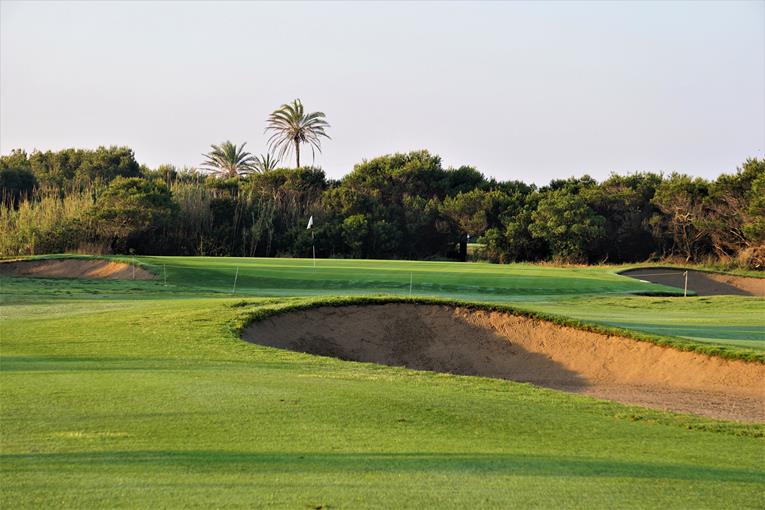
On the rare occasion Arana placed a bunker squarely in front of a green, he pulled it well back so that the hole would function well in all winds. This bunker is 40 paces from the front of the 16th green at El Saler.
El Prat, built in 1952, was considered Arana’s masterpiece. Then, the Ministry of Tourism came knocking in 1967, and asked him to build a course in the El Saler natural park south of Valencia along the Mediterranean Sea. The general area is famed for its nearby marshlands where rice is harvested for paella. The coastal pines and dunes combination surely reminded Arana of his beloved Chiberta though Chirberta’s terrain is lumpier. This proved to be his greatest canvas with half of the holes (e.g. 1-4, 10-13, 15) set in a pine forest and half being more open and coastal in flavor.
Shaped by his life experiences, Arana didn’t believe in senseless ‘window dressing’ features. The natural pine forest floor and the dunescape were preserved during construction. He moved dirt to create appealing tee and green pads and disturbed little in between. Erhardt notes that Arana dazzled people in the early days by his ability to shape the ball either way and many of his holes feature a slight bend as they flow across the property. Nothing feels manufactured or artificial and players of all abilities delight in playing. Indeed, the author witnessed an appealing large number of couples golfing during his visit; something that always portends a flexible design.
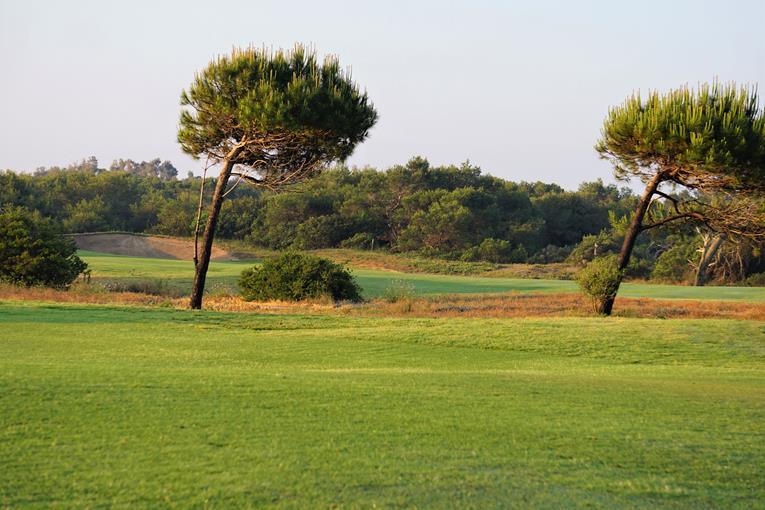
The view across the thirteenth fairway to the eleventh shows how the integrity of the property was maintained. Just as importantly, no work has been undertaken to undermine Arana’s work in the ensuing fifty years.

Ice plant, distinctively irregular trees, and the attractively colored sand take on a warm glow in the early morning light.
Arana could afford to be restrained in his architecture because he only accepted projects on land well-suited for the game. Be it Neguri high on the cliffs or El Prat along the Mediterranean or his nine holes at Algeciras which looked directly at the Rock of Gibraltar, Arana let the site’s natural beauty be the star. As Spain’s leading architect, he received the choice assignments until age slowed him down and Robert Trent Jones, Sr. came to work in southwestern Spain at Sotogrande and Valderrama. Nonetheless, Jones was never given a site as good as El Saler and not surprisingly, El Saler emerged – and remains – the country’s finest course.
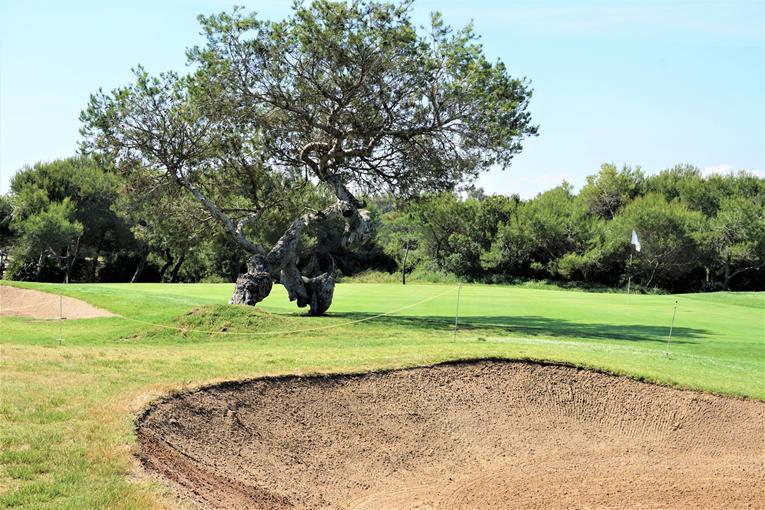
What would Arana make of this gnarled tree beside the par 5 11th green? Given that it doesn’t hinder turf coverage, he probably would enjoy the extra bite it gives this three shotter. It certainly evokes a sense of being along the Mediterranean.
One myth that surrounds the resort is that as the regional government owns and runs course, the conditioning is somehow inferior. That was untrue in May, 2018. Yes, there are many challenges to maintain a course within a natural park. For instance, departmental approval is required to remove a tree. The golfer might suspect that the course would be grossly over-treed – and that would be incorrect. As with most courses, several dozen trees could be removed for the sake of improved air circulation and sunlight. Nonetheless, the course as it is features healthy turf and plays fine, though short of bouncy-bounce. Every tee area has a wood sign that pays tribute to one species of the scores of birds that call the area home. The course is NOT maintained to the point where its coastal roots are hidden. Look at the view from the fifteenth tee below. The native floor looks just that – native! The mix of exposed sand to vegetation is balanced. Too sandy and it blows away; too much vegetation and the beach flavor vanishes. El Saler is well presented.

A perfect presentation of the sandy floor greets the golfer off the 15th tee. The fact that everything is at grade helps the eye appreciate the setting.
Erhardt quotes Arana, ‘ I hope it turns out to be a great tournament course (6,450 metres) and if I succeed, I shall retire, for I am approaching that age and want to enjoy what I have done and not have the opportunity to criticise myself.’
He would complete two additional projects but El Saler remained his crowning accomplishment. Within the seaside park, no buildings encroach on play except the resort hotel and Arana was given 1,400 yards of coastal frontage with which to work. The course also enjoys a large buffer both north and south. Chiberta has not been as fortunate, as seen above. Many architects build their best courses from their mid-30s to their mid-50s, but Arana’s life was interrupted at that age by forces beyond his control. Arana was 62 years old when worked commenced at El Saler and the veteran extracted the best possible collection of holes from the opportunity. To be clear, El Saler doesn’t offer the heart pounding moments of a Portrush or Ballybunion but Arana’s effortless style reflects the low key grace unique to the Mediterranean, as we will see below.
Holes to Note
Second hole, 380/360 yards; The second serves as an introduction to a peculiarity of Arana’s at this point in his career, namely long, slender greens that were much deeper than wide. This is the first of several that measure over 50 yards (!) from front to back. Additionally, he frequently angled them to the fairway, thus dictating a preferred side from which to approach.

The golfer who places his tee ball on the left side of the second fairway enjoys a full range of options for his approach. Not true for approaches from the right as they will be at an oblique angle.
Third hole, 535/515 yards; El Saler is a delight to walk. Why anyone would ride is a mystery, especially since the resort makes trolleys readily available, yet sometimes saying a course is easy to walk confers that the property might be flat-ish or uninteresting. Such is not the case here. In fact, of the fourteen non-one shot holes, the golfer standing on the tee only sees the flag five times. The land either has sufficient movement or the hole bends. This one is of the latter sort that bends left across land that slopes to the right. Reverse camber holes are often misunderstood, largely because they are so irritating as the land shunts the ball into disadvantageous positions.

The fairway pushes the golfer right but alas, the course’s longest hazard at 55 yards tracks along the right of the green.
continued >>>
Campo de golf del Parador de El Saler pg.ii
Fourth hole, 190/170 yards; Arana liked to pull bunkers forward on one shot holes, so gaining depth perception is no mean feat. Here, the back third of the green swoops right to a high shallow plateau where it must be the dickens to get close. During the round the author became readily aware of how the difficulty of most holes could change based on the day’s hole location. This is especially true at El Saler given the size of many of the greens. Bernhard Langer’s record breaking round of 62 in 1984 during the Spanish Open is hard to fathom. Even though the conditions were soft and the wind down, the author would love to see the pin sheet to determine the mix of hard and easy hole locations employed that historic day.
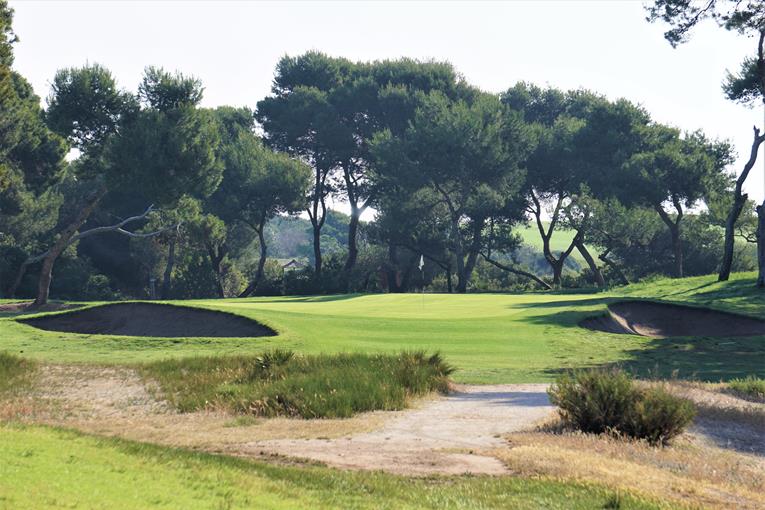
The easiest hole location makes the 4th a cheerier proposition to tackle than when the hole is placed long back right, which forces the golfer to summon the courage to fly it a good ten yards beyond the right greenside bunker.
Fifth hole, 520/495 yards; The golf emerges from a treed environment into the open with the first time golfer unsure what he will find over the crest of a dune. Full kudos to Arana, who does a masterful job of incorporating a dune line that runs at an oblique angle to the shore into the next three holes.
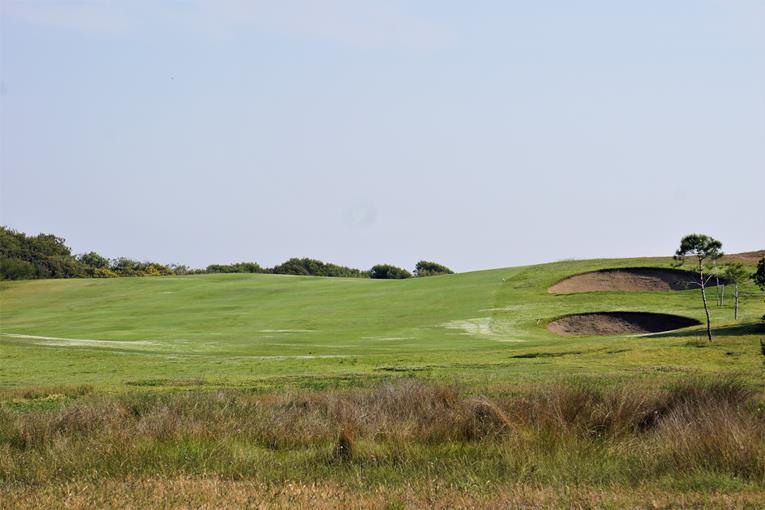
Long right is the shortest route over the dune and provides the optimal angle into the fifth green, hence the two bunkers cut into the hillside.
Sixth hole, 445/425 yards; So far, the golf has been charming as opposed to ferocious but that changes with this brute. One of Europe’s grand holes, the sixth heads back over the same dune that the golfer crossed at the fifth. As opposed to a reachable three shotter, this one is a half par hole in the other direction, i.e. a daunting two shotter where par is dearly won. Playing the fifth and sixth in nine strokes is the goal but the author ventures to say that is as often accomplished by going 4-5 as the 5-4 suggested by the scorecard. Wind makes a big difference as they play in opposite directions but it is the polar opposite green complexes that fascinate. At the fifth, the green is at grade and balls scurry on from well back. The sixth is perched with a steep six foot ramp that be adroitly scaled. It sheds most shots while the saucer fifth green complex is gathering in nature. The pair are a fine example of holes that complement each other by posing complete questions to the golfer. Six is also a prime example of a world class hole, of the sort that you only need to face once or twice in a round. Numerous such holes on one course would overwhelm the vast majority of players. While the odds are stacked against the golfer, on the rare occasion when he hits the green, it becomes seared into his memory.

The second of three consecutive tee shots where the fairway is higher than the tee. Arana surely delighted in hitting a draw to the top and then …
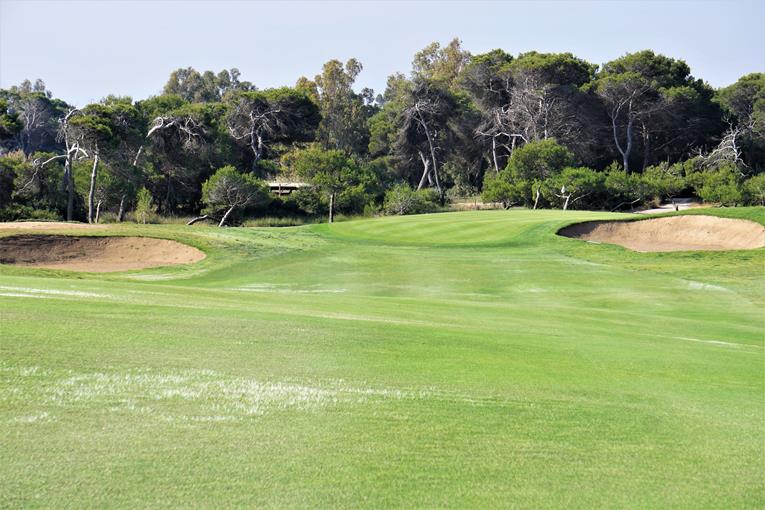
… a fade from a most unreasonable distance of ~190 yards to this angled plateau green. Such a switch back hole allows the better player to showcase his talents. Most golfers will have to fashion a low runner that climbs the dramatic false front.
Seventh hole, 360/345 yards; The seventh parallels the two prior holes and is similar off the tee in the context of unsettling optics across rolling land. The 46 yard long green features another steep rise, the third hole to do so among the first seven. It is an unusual feature that puts short grass front and center. Remembering that El Saler was built in 1967, Arana’s use of tight, short grass and his desire to see balls swept away augured the short grass rage that took hold some four (!) decades later. Colt’s St. Germaine outside of Paris has a few steep banks and one can’t help but wonder the connection.
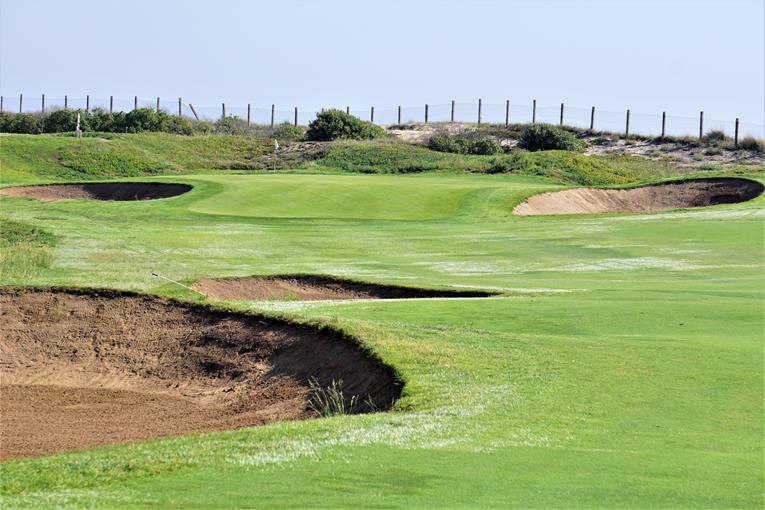
A pair of fairway bunkers guard the best angle into the long narrow green. The above photograph also captures one of the joys of a game at El Saler: the ever shifting and always appealing backdrops.
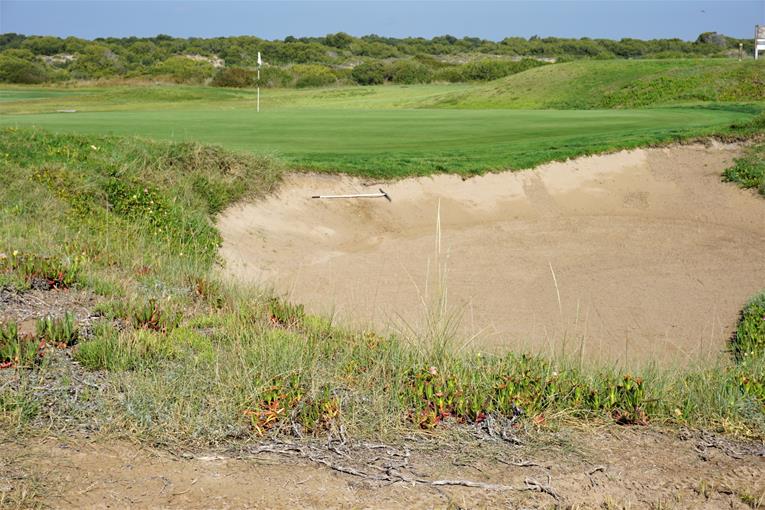
Not only do a pair of bunkers pinch the front of the green, a pair of out-of-sight bunkers are found long. The effective hitting area of the top plateau is 26 yards deep, making it – appropriately – one of the day’s most exacting targets.
Eighth hole, 360/340 yards; A very well-conceived position hole has its fairway jog to the right away from the shoreline but in a design master stroke, Arana placed the green left of a tall dune and flush to the shoreline. The right half of the green is two feet higher than the left so that high right hole locations are tricky to find from anywhere other than the left half of the fairway.
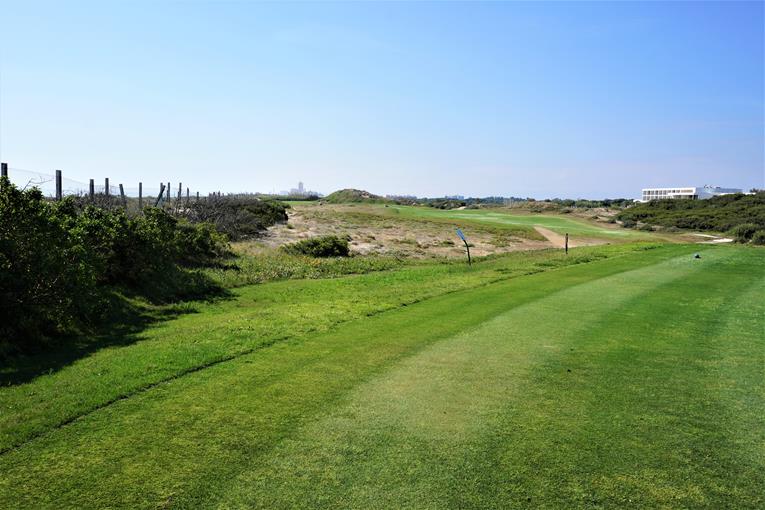
Played along the shoreline, left of the fence is ‘fuera de limites’ and a golfer doesn’t need to speak Spanish to know what that means. Still, the closer one can play down the left side of the fairway, the easier the approach.
Ninth hole, 155/140 yards; The golfer turns his back to the sea and tackles the only one shotter that heads in a westerly direction. Played over broken ground, the green is well-situated in a hollow that is handsomely framed by indigenous plants. The shortest approach shots on the first nine fall on four of the most exposed holes (e.g. the fifth, seventh, eighth, and ninth), so the ability to flight down your short irons is a skill that is rewarded at El Saler.
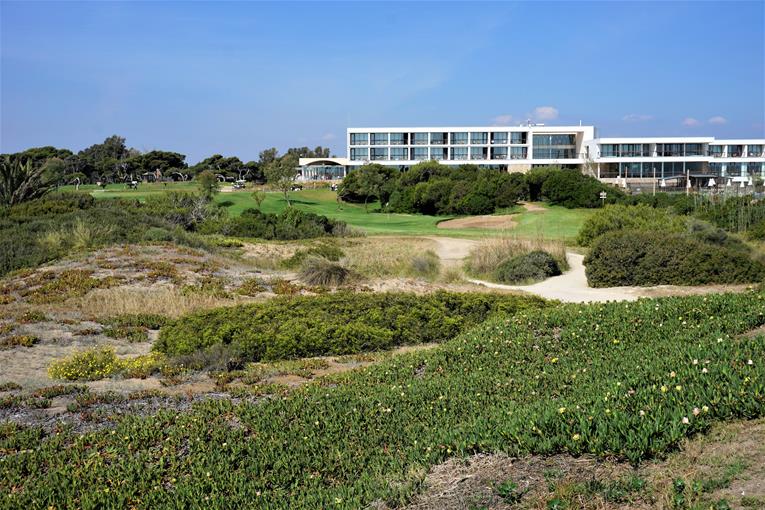
A teaser of a one shotter concludes the first nine. A long bunker that hugs the left side of the green is obscured by the plant growth. Consequently, it is one of the most highly trafficked bunkers on the course!
continued >>>
Campo de golf del Parador de El Saler pg.iii
Tenth hole, 400/390 yards; The merit of two shot holes largely defines a course, primarily because they typically outnumber one and three shot holes combined. So it is at El Saler, which enjoys the quintessential configuration of five two shotters, two three shotters, and two one shotters on each nine. Among the ten two shot holes, there are the charming drive and pitch sort (seven, eight, and thirteen), beastly ones (six and eighteen) and the all-important middle kind in the 380 to 410 yard range. In recent times much has been made of drivable two shotters and notoriety tends to follow the really hard four pars. Though they seem to have been been ignored in recent times, it is this middle range that is so important to a course’s overall fabric. For the average player who might hit a drive and mid iron, these holes are essential to bestowing good golf qualities to a course. The tenth highlights the need for a well-placed drive to a particular side of a fairway followed by an accurate iron approach. Playing smart golf, the thinking golfer has a fighting chance against the bomber at El Saler.
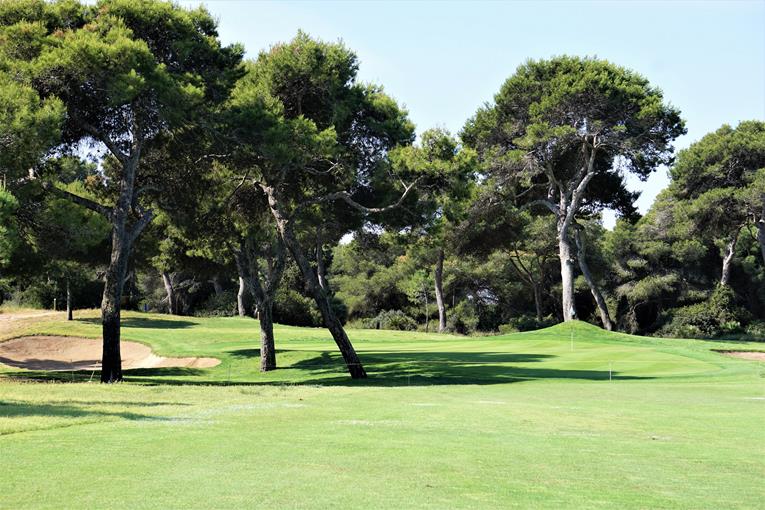
… ending at an angled green which best accepts shots played from the right half of the fairway as pines left complicate the approach. It reminds the author of the start of the back nine at Harbour Town where strategically located trees favor the golfer who can shape the ball.
Twelfth hole, 200/185 yards; To gain an appreciation of an architect, sometimes it is most instructive to see how he tackles flat land. Does he create ‘noise’ with mounding to ‘liven’ the proceedings or is he is comfortable to let a course enjoy a quiet moment so that the golfer’s senses aren’t always under assault? Arana clearly subscribed to the latter school, as did Colt and Simpson. 200 yards from the back markers, the twelfth features a high to low point of four feet – and is all the better for it. For long iron approaches, Arana liked to build greens that were deep, often times wider at the rear than the front with a one or two foot high ridge somewhere in the putting surface. Such is the case at the twelfth green, which at 53 yards, is the course’s second deepest putting surface. It adds up to golf that is challenging for the best, an easy bogey for the rest and served up in tranquil surrounds.

Today’s back left hole location on top of a tier leaves the golfer a small effective hitting area; it is amazing how the golf pivots around that two foot ridge. The lack of framing mounds elevates Arana’s work above the work that was going on in North America in the 1960s.
Thirteenth hole, 350/340 yards; The flow and pacing of an Arana course is invariably of a high standard, meaning that the golfer is never beat down or given a reason to become wholly discouraged by a string of extremely difficult holes. Yes, the eleventh is a long three shotter and the twelfth a hard one for the average player, but they are followed by this tickler. Position is everything, both off the tee and on the approach.
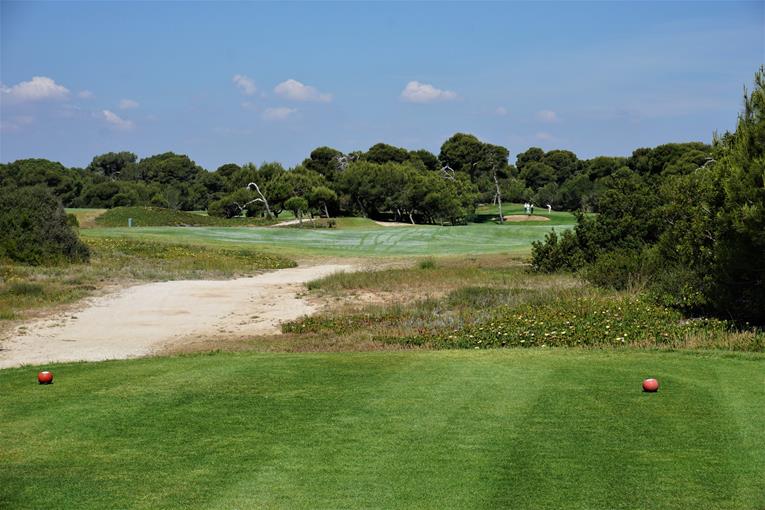
Given the day’s hole location over the left bunker, a drive down the right is optimum. In yet another example of how well the course is presented, the view down the right is obscured, thus creating a sense of doubt.
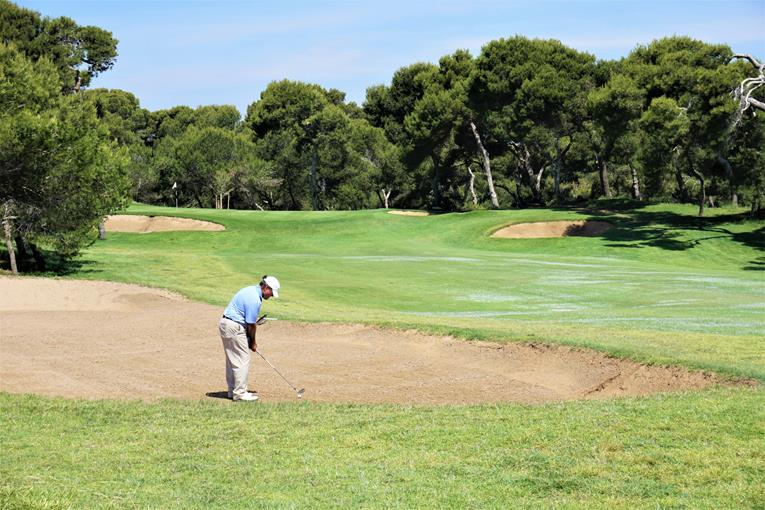
This golfer unwittingly did what many do and steered his tee ball safely left. The fairway bunker only exacerbates the difficulty of the awkward angle.
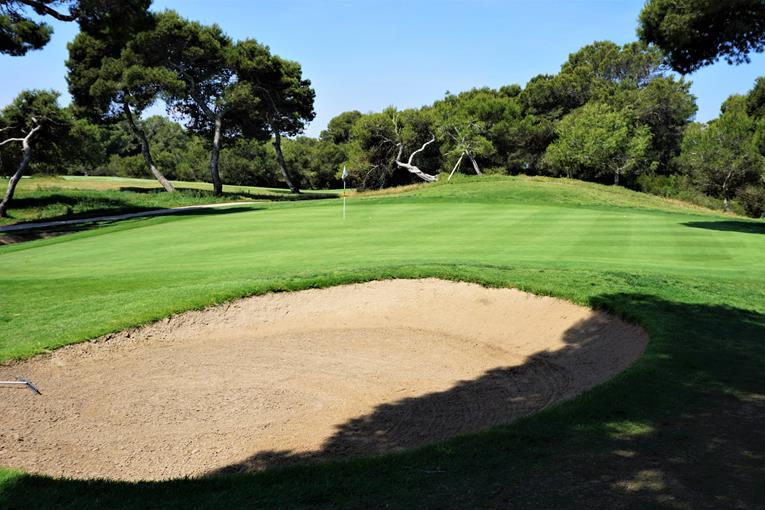
This right side view demonstrates how Arana draped the putting surface over the top of a dune. Controlling the spin is paramount as the false front occupies the first quarter of the green.
Fifteenth hole, 565/550 yards; The second nine plays a couple of hundred metres longer than the first nine, largely due to the extended length of its three shotters. This one is a slow bender to the right and the golfer needs to make sure that the slight left to right ground bias doesn’t assist him to inadvertently carve a ball right into a well-placed hazard that eats up the area 135-155 yards from the green.

Though the bunker itself isn’t particularly deep, this is known as the deepest hazard on the course as the vegetation has been cultivated to make it fierce. Second shots that peel right meet with harsh consequences.
Seventeenth hole, 215/185 yards; In another reminder of Harbour Town, two of the course’s most iconic holes close out the round and bring the golfer to the edge of a large body of water. Nestled into the main dune line and surrounded by six bunkers, the penultimate green is an island of grass in a sea of sand. Technically, there is room to run the ball up but practically there isn’t as a large fronting bunker is Arana’s way to demand a player’s very best late in the match. Still, the architectural features meld into the dunescape, allowing the setting’s purity to shine, which is exactly how design functions at its highest level. The pair of one shotters on the second nine (twelve and here) are the only two holes that play toward the Mediterranean on this side and both holes are at right angles to their predecessor. Thus, gauging the wind becomes an art form, especially here, so close to the shore.

The penultimate hole as seen early in the morning with the sun rising over the Mediterranean Sea just beyond the dunes.
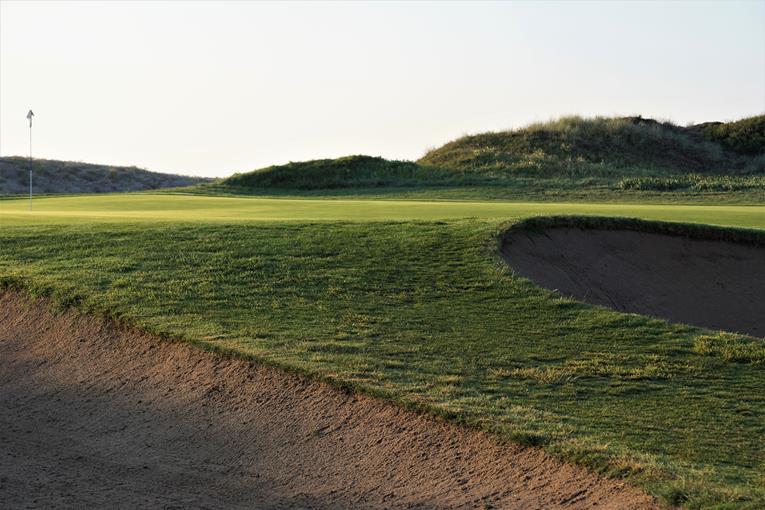
The morning light highlights the high right plateau. Even on calm days, right hole locations lend the hole wonderful playing qualities.
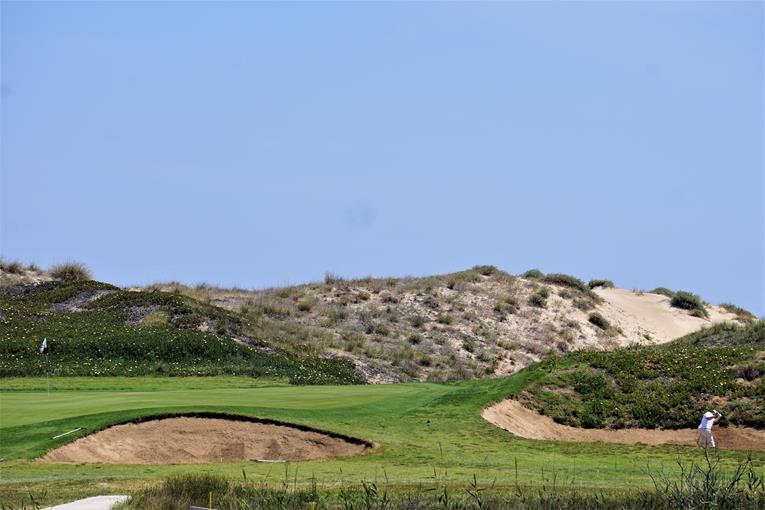
Just as Tom Simpson was prone to, Arana liked to flair bunkers away from one shot greens. The man above faces an uncommonly long greenside bunker shot.
Eighteenth hole, 470/445 yards; The views afforded from the Home tee are the best on the course and if there is a better finishing hole in continental Europe, the author hasn’t seen it. What a pity none of the Open rota courses finish in such a rousing fashion. Since Arana was an ace player, the first time player might roll his eyes and assume that Arana concluded all his courses with tough two shotters. Nothing could be farther from the truth: Real Sociedad de Golf de Neguri signs-off with a three shotter and Club de Campo Reorrido Negro in Madrid with a charming short two shotter. Arana clearly didn’t have any preconceived notions about an ideal finisher but it just so happened that a long two shotter here maximized the land’s potential.
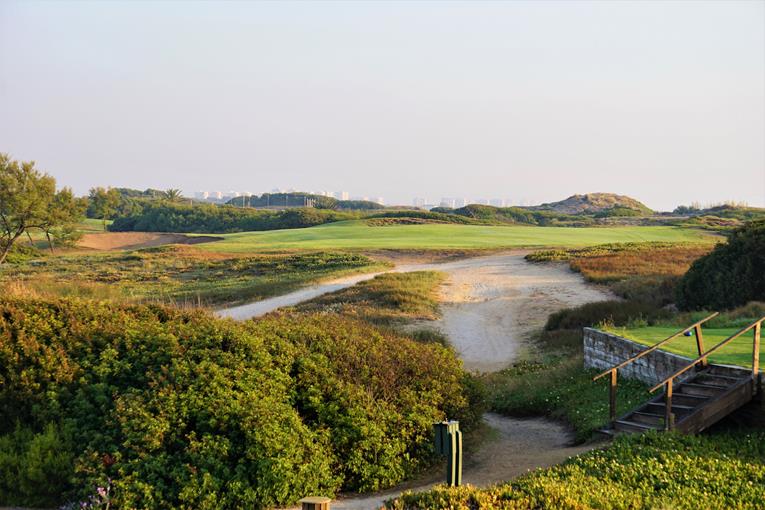
Though suitably wide, note how the eighteenth fairway gracefully tappers away both left (toward a large bunker) and right (away from the green).
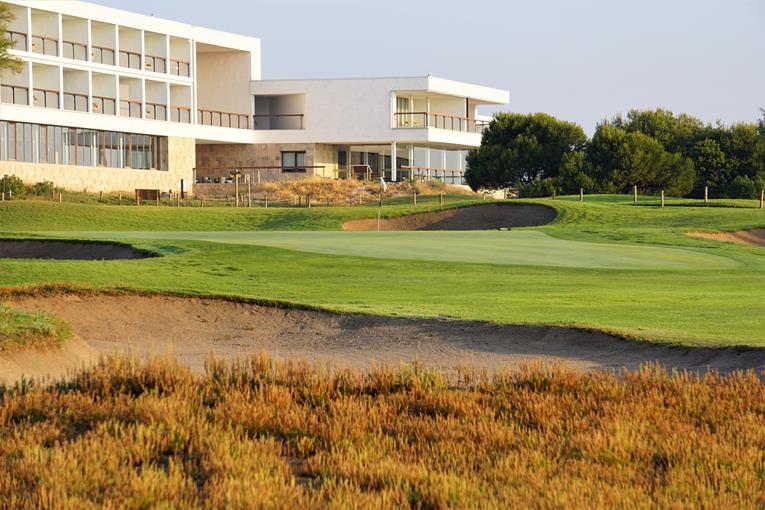
A whooping 56 yard long green means the final approach shot can vary by as much as four clubs depending upon where the hole is located.
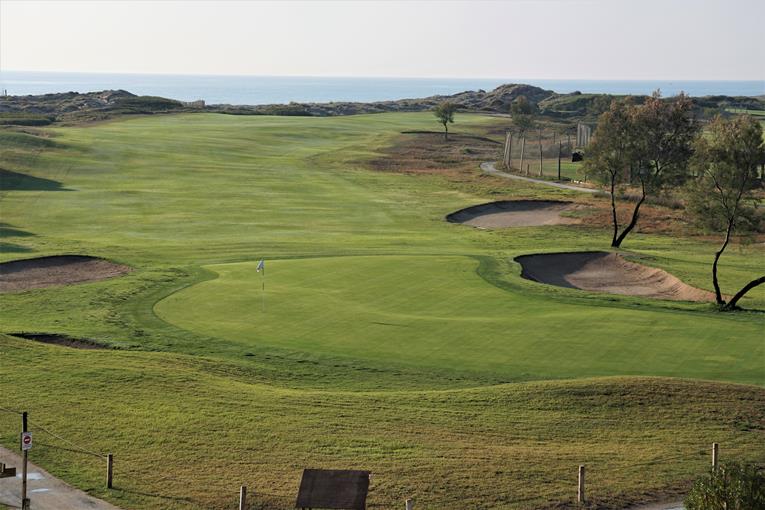
One advantage of staying at the Paradores is waking up and soaking in this view from your porch. The depth and configuration of the Home green is fully appreciated.
Imagine living in Valencia and having El Saler as your local! Fresh fruits and fish abound, Rioja and paella galore, 2,500 hours of sunshine per anum and a low profile course that changes every day as the coastal winds shift. El Saler is a walker’s paradise, just as it is a sanctuary for birds. Not very hilly but the rolls in the ground lend character to many of the holes. Maybe you have children and can bring them along or perhaps it is your daughter or son that has you as a guest? Regardless, Arana’s architecture encourages the pursuit of the sport at all ages. It doesn’t overwhelm and its lows are high while the highs (a crisp approach to the second, the terror at the approach to the sixth, the clever eighth, the thrilling finish) are all that a golfer could ask for. The only knock on El Saler is that its architecture is so inclusive that everyone enjoys playing here which stretches rounds past four hours. Tee off early in the morning, get ahead of the crowds and enjoy the flow of holes in the soothing, coastal environs.
Arana’s portfolio is only ten courses as the Spanish Civil War and World War II interrupted the game’s evolution right when Arana was at the height of his playing prowess. Yet, after touring several of his courses the golfer will yearn to see more of his work. Reading Alfonso Erhardt’s book and his Feature Interview (https://golfclubatlas.com/feature-interview/feature-interview-with-alfonso-erhardt/) are musts. Arana wasn’t splashy but he found the right sites that would yield good golf. He never tortured the land but built courses that lay peacefully upon it. Additionally, he was always mindful of the weaker player and used short grass to befuddle the tiger as opposed to fronting bunkers. To see the fairways at grade at El Saler is a stark reminder of how contorted and unnatural too many courses have become. Following in the foot steps of his mentors Colt and Simpson, Arana excelled at building courses that the golfer delights to play on a regular basis. There is no higher compliment.
Erhardt succinctly sums up Arana as an architect, ‘Throughout his life, Arana remained true to three of his master Simpson’s design theories. At El Saler we can observe that no consecutive holes are oriented in the same direction, that the optimal position from the tee is never the middle of the fairway and that most greens are angled to the fairway, favoring a particular position of the previous shot. The great HS Colt said that the test of a golf course was if it was going to live. Arana phrased it differently: do I want to play again? By combining Arana’s classic design elements, a beautifully routed property and huge green complexes, El Saler proves to be a tremendously elastic course which plays completely different from day to day. We can rest assured that 50 years after its birth El Saler lives up to Colt and Arana’s test.’
Arana didn’t invent the guitar (that was another famous Spaniard) nor for that matter, did he reinvent golf course architecture. What he did was bring a Golden Age design ethos to some of Spain’s best properties and helped set the stage for what became a golf boom in his beloved country. His passing in 1975 coincided with the emergence of Severiano Ballesteros and golf would never be the same again in Spain. As Alfonso Erhardt states, all of Spain is forever in the debt of Javier Arana.


